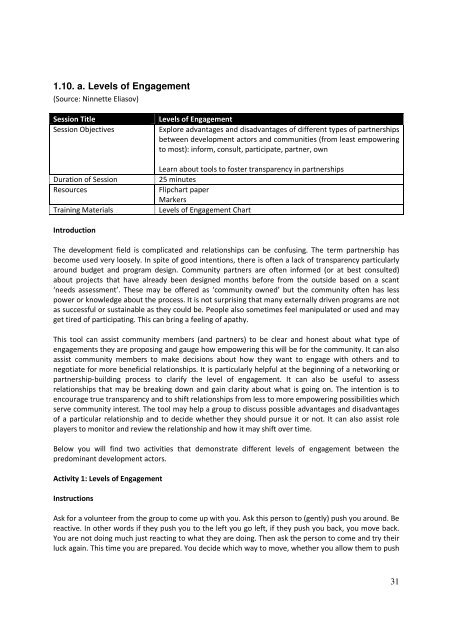ABCD-Training-of-Trainers-Tools-July-2013
ABCD-Training-of-Trainers-Tools-July-2013
ABCD-Training-of-Trainers-Tools-July-2013
You also want an ePaper? Increase the reach of your titles
YUMPU automatically turns print PDFs into web optimized ePapers that Google loves.
1.10. a. Levels <strong>of</strong> Engagement<br />
(Source: Ninnette Eliasov)<br />
Session Title<br />
Session Objectives<br />
Duration <strong>of</strong> Session<br />
Resources<br />
<strong>Training</strong> Materials<br />
Levels <strong>of</strong> Engagement<br />
Explore advantages and disadvantages <strong>of</strong> different types <strong>of</strong> partnerships<br />
between development actors and communities (from least empowering<br />
to most): inform, consult, participate, partner, own<br />
Learn about tools to foster transparency in partnerships<br />
25 minutes<br />
Flipchart paper<br />
Markers<br />
Levels <strong>of</strong> Engagement Chart<br />
Introduction<br />
The development field is complicated and relationships can be confusing. The term partnership has<br />
become used very loosely. In spite <strong>of</strong> good intentions, there is <strong>of</strong>ten a lack <strong>of</strong> transparency particularly<br />
around budget and program design. Community partners are <strong>of</strong>ten informed (or at best consulted)<br />
about projects that have already been designed months before from the outside based on a scant<br />
‘needs assessment’. These may be <strong>of</strong>fered as ‘community owned’ but the community <strong>of</strong>ten has less<br />
power or knowledge about the process. It is not surprising that many externally driven programs are not<br />
as successful or sustainable as they could be. People also sometimes feel manipulated or used and may<br />
get tired <strong>of</strong> participating. This can bring a feeling <strong>of</strong> apathy.<br />
This tool can assist community members (and partners) to be clear and honest about what type <strong>of</strong><br />
engagements they are proposing and gauge how empowering this will be for the community. It can also<br />
assist community members to make decisions about how they want to engage with others and to<br />
negotiate for more beneficial relationships. It is particularly helpful at the beginning <strong>of</strong> a networking or<br />
partnership-building process to clarify the level <strong>of</strong> engagement. It can also be useful to assess<br />
relationships that may be breaking down and gain clarity about what is going on. The intention is to<br />
encourage true transparency and to shift relationships from less to more empowering possibilities which<br />
serve community interest. The tool may help a group to discuss possible advantages and disadvantages<br />
<strong>of</strong> a particular relationship and to decide whether they should pursue it or not. It can also assist role<br />
players to monitor and review the relationship and how it may shift over time.<br />
Below you will find two activities that demonstrate different levels <strong>of</strong> engagement between the<br />
predominant development actors.<br />
Activity 1: Levels <strong>of</strong> Engagement<br />
Instructions<br />
Ask for a volunteer from the group to come up with you. Ask this person to (gently) push you around. Be<br />
reactive. In other words if they push you to the left you go left, if they push you back, you move back.<br />
You are not doing much just reacting to what they are doing. Then ask the person to come and try their<br />
luck again. This time you are prepared. You decide which way to move, whether you allow them to push<br />
31


